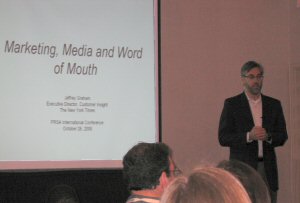 Can you truly measure the effect of word of mouth in marketing, whether it be online or offline? If so, which is more effective? Further, if so, what exactly can we as marketers do with it?
Can you truly measure the effect of word of mouth in marketing, whether it be online or offline? If so, which is more effective? Further, if so, what exactly can we as marketers do with it?
These were the bold questions set forth by Jeffrey Graham, Executive Director, Customer Insight, New York Times, in the day one PRSA International Conference Session “Word of Mouth Online or Off – What’s the Difference?”
The session’s formal agenda began with the stunning, though entirely unsurprising, admission that word of mouth, while noted as critical towards any marketing campaign’s success, is rarely accounted for in a campaigns budget.
The answer for this is surprisingly direct, in addition to being a complete cop-out: it simply cannot be measured.
Of course it can be measured. Everything can be measured. I can still measure the first fish I ever caught when I was six years old. It was 57 inches long and 32 pounds.
Now, if you are saying it can’t be measured truly accurately, then that may be something we can come closer to agreement on. In the case of a fishing story, we know before we hear the answer it will not be accurate, and the lie itself is a predictable action of the storyteller.
In fact, many in the old guard agree that the credibility of online word of mouth is negligible at best, and even among younger demographics, most word of mouth still happens – and is still trusted most – when it comes from face to face contact.
Online, does offer its share of benefits, however, including:
- Nearly absolute permanence of any conversation
- Complete transcendence of any distance
Many, however, still see it as an extremely volatile channel, and this is to be expected in any forum where anyone at anytime can post any ridiculous parable they feel like.
So knowing the influence of word of mouth, and knowing the reach of online, and admitting to the incredulity of this channel, what can savvy marketers do to be most effective?
The answer here is twofold – find what channels will spread your conversation and find the “multiplier” – those who will take the message you provide to them and multiply it among their entire network.
In terms of channels, surprisingly maybe to some – but television is still king in terms of a channel for overall “push” messaging (ie advertising) to start an online conversation. However, when this is segmented further down to the industry level – certain verticals will actually see more conversations started from online messaging, among them technology (Note: one of TopRank’s key verticals) who, research indicates will see 49 conversations started compared to television’s 37.
Significant research was done by Graham and the New York Times to determine just what exactly constitutes a multiplier, and essentially, a formula has been created that breaks it down into three basic questions:
- How many people do you speak to each day?
- Do people come to you for recommendations?
- Do you love to learn, share and advice?
Of 3000 people polled (in this case, the experiment was limited to the power of women as multipliers) roughly 30% fit this criteria.
Not only did this 30% of women match the criteria from the questions above, they also shared one other remarkable – 87% saw themselves as loving to help people – and see, either consciously or unconsciously, themselves as fulfilling some altruistic purpose in truly helping their family and friends. They were truly inspired that their networks saw them as a trusted source to go to for buying decisions.
What else did they have in common? They were each, in their own way, completely full of themselves. They loved to talk about how “I” help people, how people come to “me”. They were all – and this is purely my take – idiots.
A sandwich, like your opinion, is a wonderful thing to have, but no one wants either shoved down their throat. I myself find it hard to believe that anyone would be truly influenced by these so-called multipliers, would be interested to see truly definitive research showing otherwise – and at the end of the day – feel altruism has as much place in marketing as truth does to childhood fishing stories.
If all this is true, is this another log being placed onto a fire burning partly on pure and utter confusion, and part on the realization that we can only ever get so far inside our target’s mind?
Not quite. While we may never know definitely if a multipliers network truly likes to listen as much as multipliers love to talk – we do know – without a doubt – multipliers LOVE to buy. They will spend money because they want to, they will spend money because they feel compelled to, they will spend money because they owe it to the world to do so and share their thoughts.
The multipliers in your vertical are your big, fat target and – quite possible, just maybe – are influencing some other folks out there, too. So how best do we find them? That’s best handled more fully in another post, but an off the cuff idea is a simple three question survey:
- How many people do you speak to each day?
- Do people come to you for recommendations?
- Do you love to learn, share and advice?
Just like a fishing story, the accuracy of the response is secondary to the predictable action of the storyteller.


